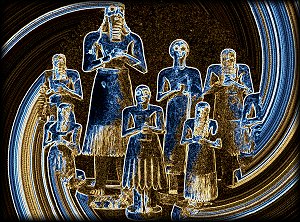I have no intention of committing myself to a chapter by chapter detailed response to Durham Bishop N. T. Wright’s The Resurrection of the Son of God as I did for Bauckham’s Jesus and the Eyewitnesses, but since Wright has (at least in discussions with me) been touted as a touchstone of scholarly authority among some fundamentalists, I can’t help but make periodic observations about his tomes, if only to hopefully leave a seed in minds of some that will one day germinate genuinely independent and honest questioning. (I’ll collate my posts that have some commentary on Wright’s works in my blog’s Book Reviews and Notes category beneath the archives links.)
The so-called early-origin of the resurrection appearances “traditions”
Wright argues that the narratives of the resurrection appearances in our canonical gospels are based on traditions that were set and hardened well before the gospels came to be written. His reasons include:
- the absence of Old Testament allusions in their narratives, in contrast to the OT riddled pre-resurrection narratives in the gospels — the argument is that the use of OT allusions were proclivities of the gospel authors, but each gospel author relied on transplanting much older traditions when it came to the resurrection scenes
- the differences among the respective resurrection accounts do not reflect theological differences and arguments found among the later church, so variant theological dispositions of the gospel authors cannot explain their narrative differences
- the different gospel accounts do not betray any textual or narrative interdependence
- I will include here Wright’s reasons for thinking it noteworthy that the gospel authors did not describe the resurrected Jesus as a shining resplendent star or such — this fact supposedly demonstrates that the early “traditions” were based on some real historical experience
These Wright arguments are by no means conclusive. They are certainly debatable, even wrong.
I’m sure more can be added to any of my comments on these below. And maybe I have missed some relevant point among Wright’s 800 pages. I’m sure someone will let me know.
Old Testament allusions in the resurrection narratives
The Gospel of Mark does not have a resurrection appearance narrative. The verses 9-20 of its final chapter are well recognized as late additions by scribes who were dissatisfied with their copies of the original all ending abruptly with the audiences’ attention directed to focus on a conclusion of silence and fear. (One might compare the conclusion of the Aeneid, even the Primary History and the Elijah-Elisha Cycle, but each of those is, well, . . . “another story”.)
The Gospel of Matthew‘s narrative of Jesus’ appearance after his resurrection is most clearly embedded in Old Testament allusion. While Dale Allison (The New Moses, A Matthean Typology) discusses the tendency of scholarship of his day to deny special Mosaic comparisons in Matthew (partly a reaction against the Straussian challenges it posed to the historicity of the gospel narrative), he nonetheless alerts us to specific stories and redaction in Matthew that demonstrably link Jesus to OT and other Jewish legendary tales about Moses. While Matthew’s gospel does not depict Jesus as a Moses figure himself, it does make use of comparisons with Moses traditions in its presentation of Jesus:
- the circumstances of his birth, with the slaughter of the infants and his divinely orchestrated escape, is undoubtedly intended to bring comparisons with Moses to mind from the beginning of the gospel
- redactional details (in comparison with the gospels of Mark and Luke) in Matthew’s telling of Jesus crossing the water and going into the wilderness to spend “forty days and nights” fasting
- the Sermon on the Mount, with its overt comparisons to Mosaic law, hits many readers as a patent transvaluing of Moses delivering the law to Israel from Mount Sinai
- Allison cites 12 points within Matthew 11:25-30 resonating with details of Moses’ unique character, and his special relationship with God and Israel
- Jesus’ specifically transvalues details of Moses in the Matthean mountain transfiguration scene
- Jesus’ final appearance, like that of Moses, is on a mountain (Deut. 32:48-50 — also, along with associated Jewish legends of this passage, a tie back to the temptation in the wilderness). Like Moses at his end, he commissions his successors (Deut 31:6-9); and as with the successor of Moses, the successors of Jesus are instructed to go out faithfully and are promised they will never be forsaken (Joshua 1:1-9).
The Gospel of Luke likewise draws on OT passages from which to construct at least one of its resurrection appearances. I have discussed these in an earlier post. Some of the key passages from there:
The Road to Emmaus story contains easily recognizable literary motifs associated with similar stories in Genesis and Judges . . . .
In Genesis Abraham sees three strangers on the road and exercises hospitality by inviting them in to eat with him; it emerges in the course of the narrative that the three strangers were angelic messengers, and one is even named “the Lord” (Genesis 18). Then two of those same strangers travel to Sodom where Lot has to work to persuade them to stay at his place before continuing their journey. It is late in the day, as in the Emmaus road story. He is unaware of their identity until later in the narrative (Genesis 19). Joshua also encountered a stranger he assumed was a fellow mortal at first but who went on to reveal himself as a divine being (Joshua 5:13-15).
When Jacob was travelling the sun set (early Jewish legends explained the pointed reference in Genesis 28:11 by saying God had caused it to set prematurely to force Jacob to stop there) and he had a dream that he was in the presence of God. God spoke to him there. And the name of the place was originally known as Luz — in the Septuagint it is Oulammaus. In the Codex Bezae this is the name used for Emmaus in Luke 24. In an early reading of Luke (perhaps the earliest) the Emmaus road revelation happened at the same place that Jacob dreamed he was visited by God.
In Judges we read about an unnamed woman who meets a “man of God”, but whom the audience knows is an angelic messenger. Her husband is named, Manoah, and he prays to God to send the same man again but this time “to us” — both of them. So God sent him again but only to his unnamed partner. She had to call Manoah to meet him. The couple, Manoah and his wife, press the “man of God” who speaks to them of divine promises to come in and stay with them in their house. A sacrifice is offered and the “man of God” reveals his true identity by disappearing before their eyes carried up into heaven by the flames and smoke of the sacrifice. (Judges 13)
This story in Judges contains many of the motifs used in Luke 24:
a. Two people receive a visit from a supernatural being.
b. Only one of the two persons is named. How readers would love to know the name of the both – in both stories. The authors of both are in some way playing with their readers’ curiosity. (Readers are told the names of both parties in all other stories where an angel comes to announce a special birth.)
c. The supernatural being speaks of divine plans and knowledge.
d. The couple invite this stranger to stay with them and eat.
e. A meal or sacrifice is begun.
f. Before the stranger eats he miraculously vanishes before the couple’s eyes
g. By witnessing this disappearing trick the couple are made aware of the identity of their guest
h. The couple speak to each other about their experience and what they have just seen and express their emotional responses.
Conclusion: It is at the very least by no means certain that at least the authors of Matthew and Luke did not construct huge chunks of their resurrection appearance scenes out of OT references.
These posts always take longer than I anticipate. Will have to discuss the other points later.

 One of the more intriguing books I read not many years ago was
One of the more intriguing books I read not many years ago was 
